Red light therapy offers you a promising solution for improving blood flow and managing diabetes. You'll benefit from its ability to reduce blood glucose levels by up to 27.7% and enhance mitochondrial function in your cells. Just 15 minutes of exposure to 670 nm red light on bare skin can boost circulation and improve insulin sensitivity. When you combine this therapy with regular exercise, a balanced diet, and proper medical treatments, you'll see even better results. From specialized beds to portable devices, various options can help you achieve better blood flow. Discover how this innovative approach fits into a thorough treatment strategy for diabetes management.
Understanding Light Therapy Benefits

Through recent medical advances, Red Light Therapy (RLT) has emerged as a promising treatment for diabetics seeking to improve blood flow and manage blood sugar levels. This non-invasive therapy uses specific wavelengths of red and near-infrared light that penetrate your skin to stimulate cellular function and enhance blood flow. RLT is considered a complementary treatment option for managing blood sugar, working best alongside traditional diabetes care.
When you undergo RLT, it boosts your body's production of adenosine triphosphate (ATP) by enhancing mitochondrial function, which improves your cellular energy and performance. You'll benefit from increased nitric oxide production, which helps relax and widen your blood vessels, leading to better circulation throughout your body.
Research shows that RLT can substantially impact your blood sugar levels, with studies reporting a 27.7% reduction in blood glucose levels after glucose intake. It's also been shown to reduce maximum glucose spiking by 7.5% in healthy individuals. For diabetics, this means you could experience better blood sugar control and improved insulin sensitivity.
You can access RLT through professional treatments or home devices, typically using them 3-5 times weekly for 10-20 minutes per session. This therapy's ability to reduce chronic inflammation and enhance cellular repair makes it particularly valuable for managing diabetes-related circulation issues.
Types of Therapeutic Light
Building on the benefits of Red Light Therapy, several distinct types of therapeutic light offer unique advantages for managing diabetes and circulation issues. Red light, which operates at wavelengths between 630-660 nm, specifically targets cellular activity and boosts circulation, making it particularly effective for diabetic patients struggling with poor blood flow. Research shows this therapy can lead to a 27.7% drop in glucose after just 15 minutes of exposure.
Near-infrared light therapy uses longer wavelengths (810-850 nm) and falls under the broader category of low-level light therapy (LLLT). You'll find this type particularly effective because it penetrates deeper into your tissues than standard red light.
Both these treatments are forms of photobiomodulation, which means they stimulate cellular processes to promote healing and improve circulation.
LED light therapy has become increasingly popular due to its precision and intensity. You'll benefit from powerful LED devices that can deliver concentrated beams of both red and near-infrared light directly to problem areas.
Whether you're using a professional system or an at-home device, you'll find that these different light therapies can work together or independently to address your specific circulatory needs and diabetic complications.
Blood Flow Enhancement Methods
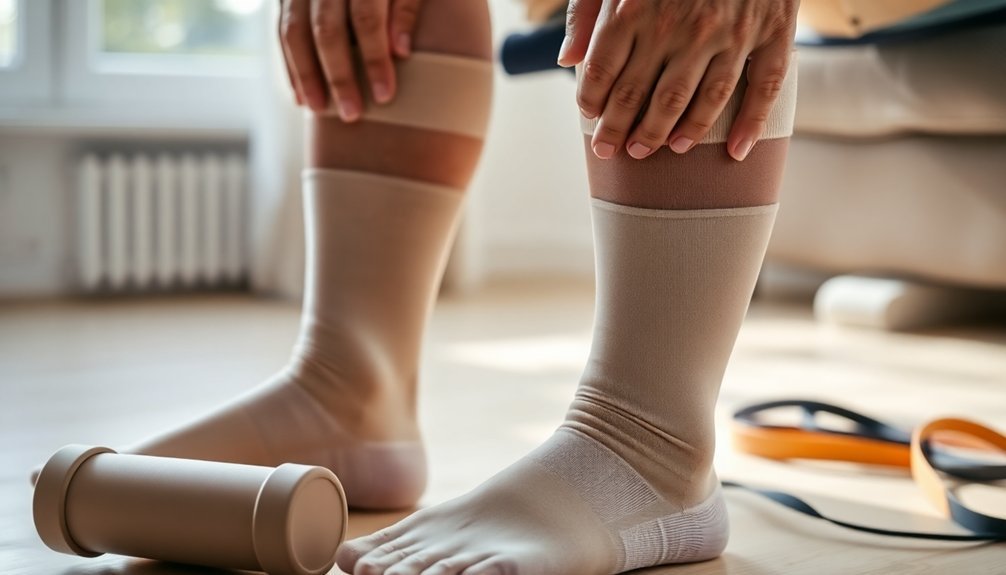
While managing diabetes requires a multifaceted approach, enhancing blood flow stands as a critical component of effective treatment. You'll find several evidence-based methods to improve your circulation and maintain healthy blood vessels. High blood sugar levels can lead to fatty deposits building up in blood vessels, making circulation management essential.
Regular exercise plays a crucial role in boosting your blood flow. You should aim for at least 150 minutes of moderate-intensity aerobic activity weekly, and incorporate short, frequent exercises like squats and leg lifts every 30 minutes.
When combined with proper diet and hydration, these activities markedly enhance your cardiovascular health.
Therapeutic Interventions:
Blood flow restriction training can improve your glucose metabolism, while compression socks help reduce swelling in your legs and feet. Don't overlook the benefits of biofeedback-assisted relaxation training for widening peripheral blood vessels.
Lifestyle Modifications:
Focus on maintaining a balanced diet rich in fiber and lean proteins, and quit smoking to reduce blood vessel damage.
Preventive Measures:
Monitor your blood sugar levels regularly, manage your blood pressure, and practice stress-reduction techniques like deep breathing exercises to maintain healthy circulation.
Infrared Light Treatment Options
Infrared light therapy stands out as a promising treatment option for diabetics struggling with poor circulation. You'll find several treatment methods that use different wavelengths of infrared light to improve blood flow and manage diabetes-related complications.
| Treatment Type | Benefits |
|---|---|
| Far-Infrared Radiation | Enhances blood circulation to feet, especially during hemodialysis |
| Pulsed Infrared Light | Improves peripheral sensation and reduces neuropathy symptoms |
| Red Light Therapy | Assists with wound healing and blood glucose control |
| Combined Therapy | Provides extensive treatment for multiple diabetic complications |
You can expect treatment sessions to last 10-20 minutes, typically scheduled 3-5 times per week. The therapy works by stimulating nitric oxide production in your body, which naturally dilates blood vessels and improves circulation. It's particularly effective when applied to areas where circulation is most compromised, such as your feet and hands.
Clinical studies show both objective and subjective improvements in patients using infrared light therapy. You'll likely notice reduced tingling and coldness in your extremities as the therapy improves blood flow and enhances cellular repair through increased mitochondrial energy production. Regular treatments can significantly reduce swelling and discomfort in the legs associated with diabetic vascular complications.
Red Light Application Techniques
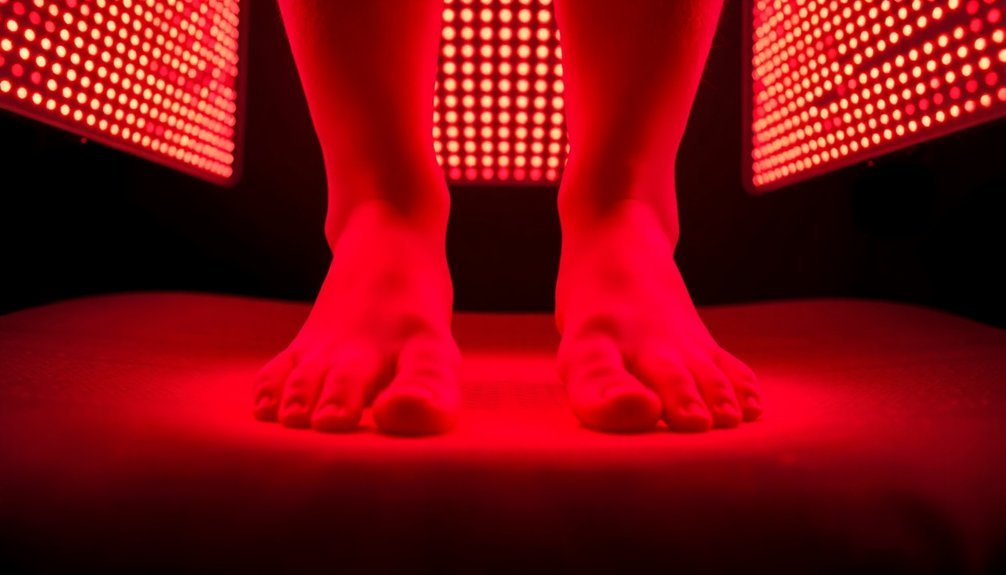
Today, red light therapy offers diabetics a promising approach to blood sugar management through specific application techniques. When you receive this treatment, you'll be exposed to specific wavelengths, typically around 670 nm, using specialized beds or portable devices. You'll need about 15 minutes of exposure to the upper back area where your bare skin directly receives the therapeutic light.
The application process focuses on three key mechanisms:
- Direct mitochondrial stimulation to boost cellular energy production and ATP levels
- Enhanced glucose metabolism through improved cellular function
- Overall metabolic improvement through sustained mitochondrial activation
You'll need professional guidance to guarantee proper treatment, as the right approach can lead to significant benefits, including a 27.7% reduction in blood glucose levels and a 7.5% decrease in maximum glucose spikes.
When selecting a device, like the TheraLight 360 HD, you'll want to evaluate its specific wavelength capabilities and professional recommendations. Remember that red light therapy works best as part of a thorough strategy that includes diet, exercise, and other lifestyle modifications.
While research continues, this therapy shows promise as a complementary treatment for diabetes management.
Light Therapy Treatment Duration
You'll need to dedicate 10 to 30 minutes per session for effective red light therapy, with treatments typically occurring several days per week for approximately 12 weeks.
Your specific treatment duration will depend on your diabetic condition's severity, though research shows even a single 15-minute session can help reduce blood sugar levels.
While consistency is key to achieving ideal results, you should always consult your healthcare provider to determine the most appropriate treatment length and frequency for your situation.
Treatment Length Guidelines
In accordance with clinical research, light therapy treatments for diabetics typically range from 10 to 30 minutes per session, with most patients requiring multiple sessions across a 12-week period.
You'll need to maintain consistency in your treatment schedule to achieve the best results, as studies have shown specific benefits like a 27.7% reduction in blood glucose levels with 15-minute exposures.
The length of your treatment may vary based on your specific condition and response to therapy. When you're dealing with wound healing, you might need treatments three times a week for about 8 weeks using LED phototherapy.
Your healthcare provider will help determine the most effective duration based on your needs.
Here are key factors that'll influence your treatment length:
- Severity of your diabetic neuropathy – more severe cases may require longer or more frequent sessions
- Type of wavelength used (625, 660, or 850 nm) – different wavelengths can affect treatment duration
- Your body's response to the therapy – some patients may need adjusted durations based on their progress
Remember to integrate light therapy as part of a thorough treatment approach that includes proper diet, exercise, and prescribed medications.
Daily Session Requirements
Throughout your light therapy journey, maintaining proper daily session requirements is essential for managing diabetic symptoms effectively. Your sessions should typically last between 10 to 30 minutes, depending on your specific condition and treatment goals.
When treating diabetic neuropathy, you'll need to schedule sessions a few days per week over approximately 12 weeks.
For chronic wound healing, you'll need to commit to three sessions weekly for about 8 weeks using LED phototherapy. If you're using light therapy to improve mood and insulin sensitivity, plan for daily 30-minute sessions every morning over 4 weeks.
You'll want to use appropriate wavelengths – 670 nm red light has shown promising results for blood sugar management.
During your sessions, you'll need to directly expose the treatment area to the light source, whether you're using a full-body pod or targeted panel device. Don't forget to wear eye protection, and start with shorter sessions if you have sensitive skin.
It's vital to consult your doctor about the right treatment duration for your specific needs, as individual responses to light therapy can vary.
Circulation Improvement Protocols
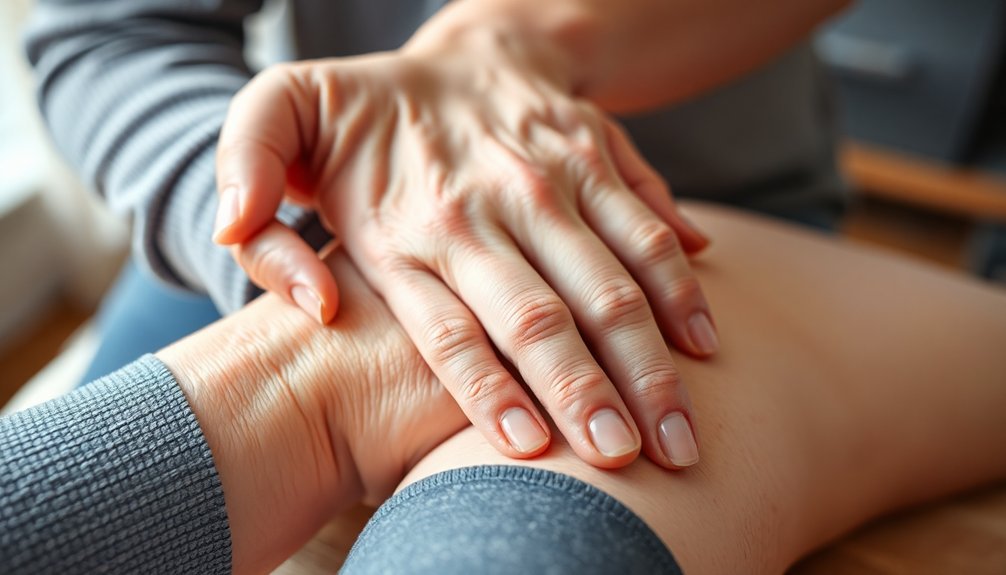
To improve your circulation as a diabetic, you'll need to engage in regular physical activity, including 30 minutes of moderate-intensity exercise five days a week through activities like walking, swimming, or biking.
You should closely monitor your blood sugar levels, keeping them between 80-130 mg/dL before meals, while following prescribed medical treatments such as blood thinners or compression therapy when recommended by your healthcare provider.
Optimizing your lifestyle through hydration, weight management, smoking cessation, and proper foot care will further enhance your blood flow and overall circulatory health.
Exercise And Movement Protocols
A well-structured exercise program plays a vital role in managing diabetes and improving circulation. You'll need at least 150 minutes of moderate-to-vigorous aerobic activity weekly, spread across three or more days.
It's imperative to combine both aerobic and resistance training to enhance your cardiovascular health and improve insulin sensitivity.
To maximize your circulation benefits, focus on activities that get your heart rate between 65-90% of its maximum. Walking, swimming, cycling, and aerobics are particularly effective choices for improving blood flow. Before starting any new exercise routine, make sure you get clearance from your healthcare provider, especially if you've been inactive.
- Begin with low-impact exercises and gradually increase intensity as your fitness improves
- Monitor your heart rate to stay within the target zone for maximum circulation benefits
- Include resistance training at least twice weekly to improve muscle strength and blood glucose control
You'll experience multiple benefits from regular exercise, including enhanced insulin sensitivity, better weight management, reduced HbA1c levels, and improved cardiovascular health. Remember to stay consistent with your routine to maintain these positive effects on your circulation.
Medical Treatment Approaches
Beyond lifestyle changes like exercise, medical interventions offer powerful tools for improving circulation in diabetic patients. Your doctor may prescribe blood thinners like aspirin or warfarin to prevent clotting and improve blood flow. Statins help control cholesterol levels, while blood pressure medications and vasodilators work to manage hypertension and dilate your blood vessels.
You'll find various therapeutic approaches available, including thermal biofeedback and massage therapy, which can substantially boost peripheral circulation. Compression therapy using diabetic socks and regular foot elevation helps reduce swelling and enhance blood flow.
For more severe cases, you might need surgical interventions like angioplasty or bypass surgery to restore proper circulation.
Regular monitoring is essential for successful treatment. You'll need to schedule frequent check-ups with your healthcare provider and possibly consult a vascular surgeon for expert assessment. They'll monitor your blood sugar levels and check for iron deficiency, which can impact circulation.
Your treatment plan may also include specialized wound care techniques like vacuum-assisted closure or hyperbaric oxygen therapy if you develop diabetic foot wounds.
Lifestyle Optimization Methods
Making impactful lifestyle changes stands at the forefront of improving circulation for diabetics. You'll need to focus on dietary modifications, physical activity, and stress management to optimize your blood flow.
Your food choices should emphasize fiber-rich options, healthy fats from sources like salmon and walnuts, and proper portion control while maintaining adequate water intake of at least 8 glasses daily.
Exercise plays a vital role in enhancing circulation. You should aim for:
- 150 minutes of moderate-intensity aerobic exercise weekly, incorporating activities like walking, cycling, or swimming
- Regular strength training sessions to improve insulin sensitivity and blood sugar management
- Daily flexibility exercises such as yoga or tai chi to reduce stress and enhance mobility
Don't overlook the importance of foot care. Elevate your feet regularly, use warm foot soaks, and consider wearing compression socks to stimulate blood flow.
You'll also want to maintain healthy cholesterol levels and keep your blood sugar between 80-130 mg/dL before meals.
Remember to schedule regular check-ups with your healthcare provider to monitor your circulation and foot health progress.
Combining Therapies For Results
Modern diabetes management increasingly relies on strategic combinations of therapies to maximize patient outcomes. You'll find substantial benefits when combining specific treatments, particularly in addressing blood flow and cardiovascular health.
| Therapy Combination | Key Benefits |
|---|---|
| SGLT2 inhibitors + GLP-1RAs | Reduces cardiovascular events by 11%, slows kidney function loss by 60% |
| Aspirin + Rivaroxaban | Decreases cardiovascular events and mortality rates |
| Blood Flow Restriction + Electrical Stimulation | Prevents muscle mass loss and improves circulation |
| SGLT2 inhibitors + Standard Care | Reduces heart failure hospitalization by 23% |
| Combination Monitoring + Medication | Enhances safety and prevents drug interactions |
You'll achieve the best results by combining these therapies under proper medical supervision. For instance, when you pair SGLT2 inhibitors with GLP-1 receptor agonists, you'll experience improved cardiovascular protection and kidney function without additional safety concerns. Similarly, combining aspirin with rivaroxaban can markedly reduce your risk of cardiovascular events, though you'll need careful monitoring for bleeding risks. If you're concerned about muscle health, the combination of blood flow restriction and electrical stimulation therapy can help prevent diabetes-related muscle deterioration while improving circulation.
Home Light Treatment Solutions
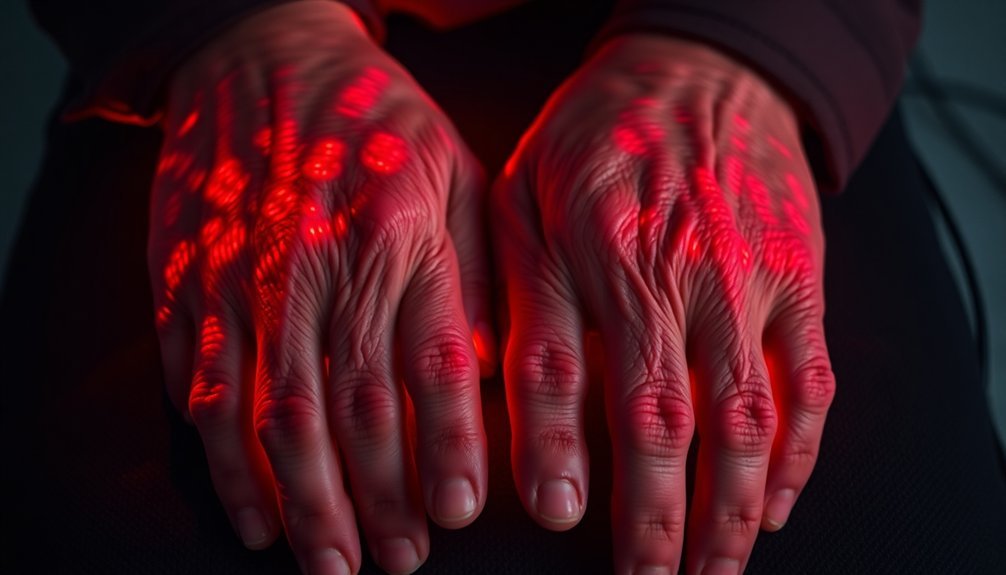
Light therapy has emerged as a promising home treatment option for managing diabetes-related circulation issues. When you use light therapy devices at home, they work by stimulating nitric oxide production, which helps relax your blood vessels and improve blood flow.
These treatments enhance cellular repair and boost microcirculation, particularly beneficial for diabetics struggling with poor circulation in their extremities.
You'll find various home light therapy devices designed specifically for diabetes management:
- LED panels and handheld units that emit specific wavelengths (625, 660, 850 nm) to target circulation problems
- FDA-cleared foot pain relief devices that focus on improving blood flow in diabetic feet
- Whole-body light therapy beds offering extensive treatment with adjustable frequencies
For best results, you'll want to use these devices 3 to 5 times weekly for 10 to 20 minutes per session. Focus the treatment on areas with poor circulation, like your legs, feet, and hands.
You can enhance the effectiveness by combining light therapy with other treatments such as exercise or massage. Remember to start with shorter sessions and gradually increase duration as your body adjusts to the treatment.
Professional Light Therapy Services
Professional clinics offer substantially more advanced light therapy solutions than home-based options for managing diabetes-related circulation issues. You'll find high-powered equipment that delivers deeper tissue penetration using specific wavelengths between 600-1000 nm, which can more effectively stimulate blood flow and reduce inflammation.
When you visit a professional light therapy clinic, you'll receive tailored treatment plans typically consisting of 3-5 sessions per week, with each session lasting 10-20 minutes. These sessions specifically target conditions like peripheral artery disease, diabetic neuropathy, and chronic venous insufficiency.
The clinic's advanced equipment can effectively boost nitric oxide production, leading to improved vasodilation and enhanced circulation throughout your body.
Your treatment at a professional clinic will be guided by experts who can adjust the therapy based on your specific needs and monitor your progress. They'll often combine light therapy with other treatments like exercise and massage therapy for maximum results.
The clinical setting also guarantees you're receiving treatment backed by ongoing research and studies, particularly focusing on wound healing, pain reduction, and improved microcirculation in diabetic patients.
Frequently Asked Questions
Can Massage Therapy Help Improve Blood Circulation in Diabetic Patients?
Yes, you'll find massage therapy effectively improves your blood circulation as a diabetic patient. It'll enhance blood flow, expand blood vessels, and increase oxygen delivery while supporting better tissue health and wound healing.
How Does Acupuncture Affect Blood Flow for People With Diabetes?
When you get acupuncture, it'll stimulate your circulation, helping distribute nutrients and remove waste products more efficiently. It'll improve your blood sugar regulation and reduce inflammation while enhancing insulin sensitivity in your body.
What Role Does Hyperbaric Oxygen Therapy Play in Diabetic Circulation?
Hyperbaric oxygen therapy boosts your diabetic circulation by flooding tissues with oxygen, forming new blood vessels, and improving overall blood flow. You'll get enhanced wound healing and better tissue regeneration through regular treatments.
Is Ultrasound Therapy Effective for Improving Diabetic Peripheral Circulation?
Yes, ultrasound therapy's proven highly effective for your diabetic circulation. It'll enhance blood flow in your peripheral vessels, improve perfusion, and stimulate circulation in your feet through non-invasive acoustic wave treatments.
Can Electrical Stimulation Therapy Enhance Blood Flow in Diabetic Feet?
Yes, electrical stimulation therapy can enhance blood flow in your diabetic feet. It's proven to increase circulation, promote vasodilation, and stimulate lower limb muscles, helping prevent ulcers and improve overall foot health.
In Summary
You've learned that light therapy can substantially boost your circulation as a diabetic. By using infrared and red light treatments, you'll improve blood flow to your extremities and promote healing. Whether you choose home devices or professional services, you'll find these non-invasive therapies work well alone or combined with other treatments. Stay consistent with your light therapy sessions to maintain better circulation and manage your diabetic symptoms effectively.

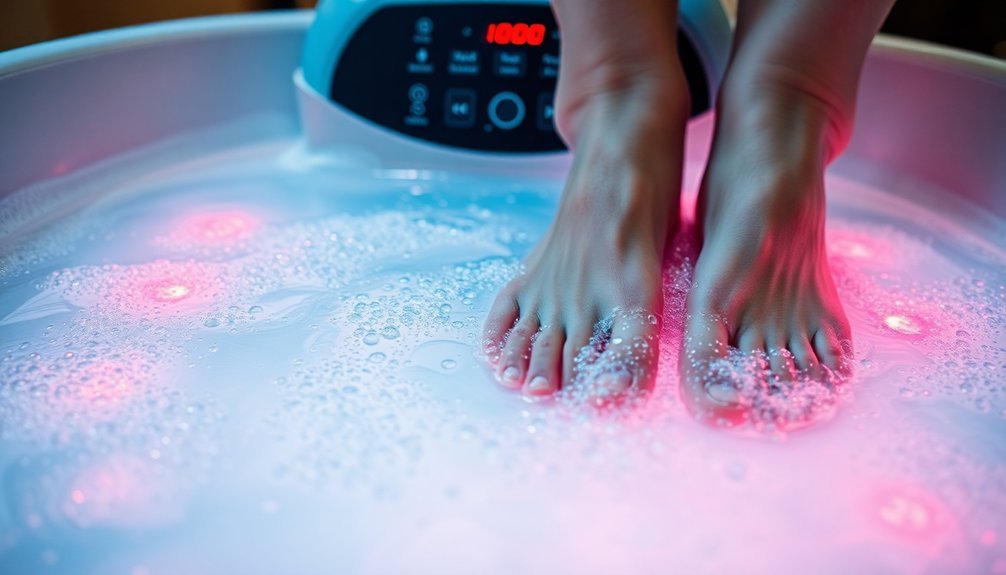



Leave a Reply